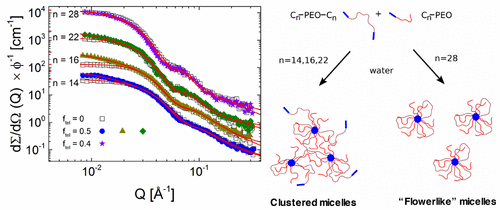当前位置:
X-MOL 学术
›
Macromolecules
›
论文详情
Our official English website, www.x-mol.net, welcomes your
feedback! (Note: you will need to create a separate account there.)
Self-Assembly of Mixtures of Telechelic and Monofunctional Amphiphilic Polymers in Water: From Clusters to Flowerlike Micelles
Macromolecules ( IF 5.1 ) Pub Date : 2017-09-13 00:00:00 , DOI: 10.1021/acs.macromol.7b01501 Thomas Zinn 1 , Lutz Willner 2 , Kenneth D. Knudsen 3 , Reidar Lund 1
Macromolecules ( IF 5.1 ) Pub Date : 2017-09-13 00:00:00 , DOI: 10.1021/acs.macromol.7b01501 Thomas Zinn 1 , Lutz Willner 2 , Kenneth D. Knudsen 3 , Reidar Lund 1
Affiliation

|
We study the self-assembly of mixtures of n-alkyl mono- and difunctionalized poly(ethylene oxide) (PEO) chains in the dilute concentration regime. The monofunctional PEOs were prepared by living anionic polymerization with varying n-alkyl length (n = 14, 16, 22, 28) and constant PEO molecular weight of 5 kg/mol. The difunctional materials were obtained through end-to-end coupling of two of the monofunctionalized PEOs via their terminal hydroxyl groups. The chosen synthetic pathway yields well-defined model compounds with narrow molecular weight distribution and complete end-group functionalization. By using both small-angle neutron scattering (SANS) and dynamic light scattering (DLS) combined with theoretical data modeling, we have systematically investigated both the global and inner structure of the self-assembled micellar structures. For short n-alkyl chain-ends, we find a formation of clustered micelles with a finite size whereas, intriguingly, at longer n-alkyls, we observe a crossover to flowerlike micelles. This was confirmed both by DLS, which is very sensitive to formation of larger clusters, as well as with SANS, which also showed a clear transition from attractive to repulsive intermicellar interactions upon increasing n-alkyl length. We attribute this to the balance between the hydrophobic enthalpic terms that favor anchoring of both chain-ends to the core and the entropic cost associated with the bending of the polymer chains. For short n-alkyls, exposure of the chain-ends in the corona structure leads to net dominance of the attractive interactions while for longer hydrophobic chains it leads to a stabilization of loops and consequently flowerlike micellar morphology. Using contrast-variation SANS, the contribution of mono- and difunctional chains could be separated, confirming the flowerlike micellar structure.
中文翻译:

遥测和单官能两亲聚合物在水中的混合物的自组装:从簇到花状胶束
我们研究了稀浓度条件下正烷基单官能和双官能化聚环氧乙烷(PEO)链混合物的自组装。单官能PEO是通过具有变化的正烷基长度的活性阴离子聚合制备的(n= 14、16、22、28),且PEO的恒定分子量为5 kg / mol。通过两个单官能化PEO经由其末端羟基的端对端偶联获得双官能材料。选择的合成途径可产生分子量分布窄且端基官能团完全的定义明确的模型化合物。通过同时使用小角度中子散射(SANS)和动态光散射(DLS)与理论数据建模相结合,我们系统地研究了自组装胶束结构的整体和内部结构。对于短的n烷基链端,我们发现形成了大小有限的簇状胶束,而有趣的是,在较长的n处-烷基,我们观察到与花状胶束的交叉。DLS和SANS都证实了这一点,DLS对较大簇的形成非常敏感,DLS对正烷基长度的增加也显示出从吸引性相互作用向排斥性胶束间相互作用的明显转变。我们将其归因于疏水性焓术语之间的平衡,该术语有利于将两个链端均锚定至核心,并且熵成本与聚合物链的弯曲相关。简而言之n-烷基,电晕结构中链末端的暴露导致吸引相互作用的净优势,而对于更长的疏水链,则导致环的稳定化,并因此导致花状胶束形态。使用对比变化SANS,可以分离单功能链和双功能链的贡献,从而确认花状胶束结构。
更新日期:2017-09-13
中文翻译:

遥测和单官能两亲聚合物在水中的混合物的自组装:从簇到花状胶束
我们研究了稀浓度条件下正烷基单官能和双官能化聚环氧乙烷(PEO)链混合物的自组装。单官能PEO是通过具有变化的正烷基长度的活性阴离子聚合制备的(n= 14、16、22、28),且PEO的恒定分子量为5 kg / mol。通过两个单官能化PEO经由其末端羟基的端对端偶联获得双官能材料。选择的合成途径可产生分子量分布窄且端基官能团完全的定义明确的模型化合物。通过同时使用小角度中子散射(SANS)和动态光散射(DLS)与理论数据建模相结合,我们系统地研究了自组装胶束结构的整体和内部结构。对于短的n烷基链端,我们发现形成了大小有限的簇状胶束,而有趣的是,在较长的n处-烷基,我们观察到与花状胶束的交叉。DLS和SANS都证实了这一点,DLS对较大簇的形成非常敏感,DLS对正烷基长度的增加也显示出从吸引性相互作用向排斥性胶束间相互作用的明显转变。我们将其归因于疏水性焓术语之间的平衡,该术语有利于将两个链端均锚定至核心,并且熵成本与聚合物链的弯曲相关。简而言之n-烷基,电晕结构中链末端的暴露导致吸引相互作用的净优势,而对于更长的疏水链,则导致环的稳定化,并因此导致花状胶束形态。使用对比变化SANS,可以分离单功能链和双功能链的贡献,从而确认花状胶束结构。











































 京公网安备 11010802027423号
京公网安备 11010802027423号